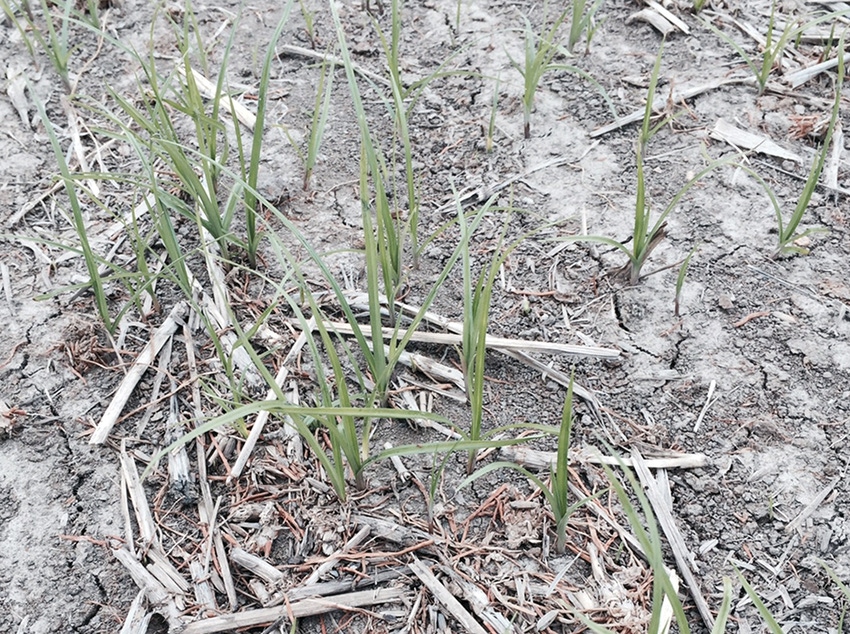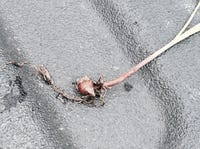May 3, 2016

My rice calls to date can be summarized with one word — sedges! I have never received so many early-season sedge calls.
My university counterparts are telling me the same thing.
A lot of the calls are about situations where there has been no previous history of severe sedge problems. In some cases the sedges are emerging before the rice.
Given the increase in sedges over the past few years, this problem must be dealt with very seriously.
The predominant two sedges infesting rice in Arkansas are yellow nutsedge and rice flatsedge. These two weeds can be difficult to identify in the seedling stage and the management practices for the two are very different.
The University of Arkansas has a fact sheet that is helpful, but identification in the seedling stage can be more anecdotal than scientific.

Seedling yellow nutsedge showing early development of rhizomes. Photo: Ford Baldwin (click to enlarge)
Seedling yellow nutsedge showing early development of rhizomes. Photo: Ford Baldwin (click to enlarge)What has complicated things for me somewhat this year is I am identifying a lot of the plants as yellow nutsedge, but they are coming from fields with a previous history of rice flatsedge.
Identification is much easier when you have the two to compare, but often this is not possible.
Yellow nutsedge plants tend to be more solitary and the leaves are wider than those of rice flatsedge. Yellow nutsedge tends to start developing white fleshy rhizomes early; whereas the roots on rice flatsedge are very fibrous.
If yellow nutsedge is suspected, dig carefully and look for the small, round tubers or nuts. Keep in mind they are sometimes difficult to find.
Rice flatsedge tends to occur in very dense populations, making it difficult to separate individual plants. The leaves are very narrow and the roots have a very distinct and sweet smell when crushed between your fingers. It also normally only germinates after periods of saturated soil.
With yellow nutsedge, the ALS inhibiting herbicides — Permit, Permit Plus and Halomax — are required.

Seedling yellow nutsedge showing the tuber or nut. Photo: Ford Baldwin (click to enlarge)
Seedling yellow nutsedge showing the tuber or nut. Photo: Ford Baldwin (click to enlarge)Some consultants are going after these early populations very quickly and I do not disagree. If you are 100 percent confident the plants are all yellow nutsedge, timing of the Permit/Halomax-type of applications is not extremely critical.
Management of rice flatsedge is totally different. As far as I am concerned you can treat every infestation of rice flatsedge like it was ALS-resistant. One reason it has been such a huge issue the past couple of years is folks treated with Permit or Halomax assuming control and didn’t recognize a failure until flatsedge blew through postflood.
The herbicides that have good activity on rice flatsedge are propanil, thiobencarb (Bolero) and bentazon (Basagran and Broadloom). Also, timing is important and the earlier the better. On very small rice flatsedge I like RiceBeaux because it contains propanil and thiobencarb.
As the sedge gets larger, adding bentazon to the RiceBeaux or propanil is the most effective treatment. With a lot of the calls this year I have been hedging the bet so to speak.
Not being 100 percent confident a proper identification has been made, I have been recommending RiceBeaux plus Permit, Permit Plus or Halomax. The RiceBeaux will be good if it is small rice flatsedge, and I like thiobencarb in the program anyway. If it is yellow nutsedge, the Permit treatment will be effective and if it is a mixture of the two weeds, the treatment will still cover it.
Ford Baldwin served as a weed scientist with the University of Arkansas Cooperative Extension Service from 1974 to 2001. Since 2002, he has been a partner in Practical Weed Consultants with his wife, Tomilea. Contact him at [email protected].
About the Author(s)
You May Also Like




